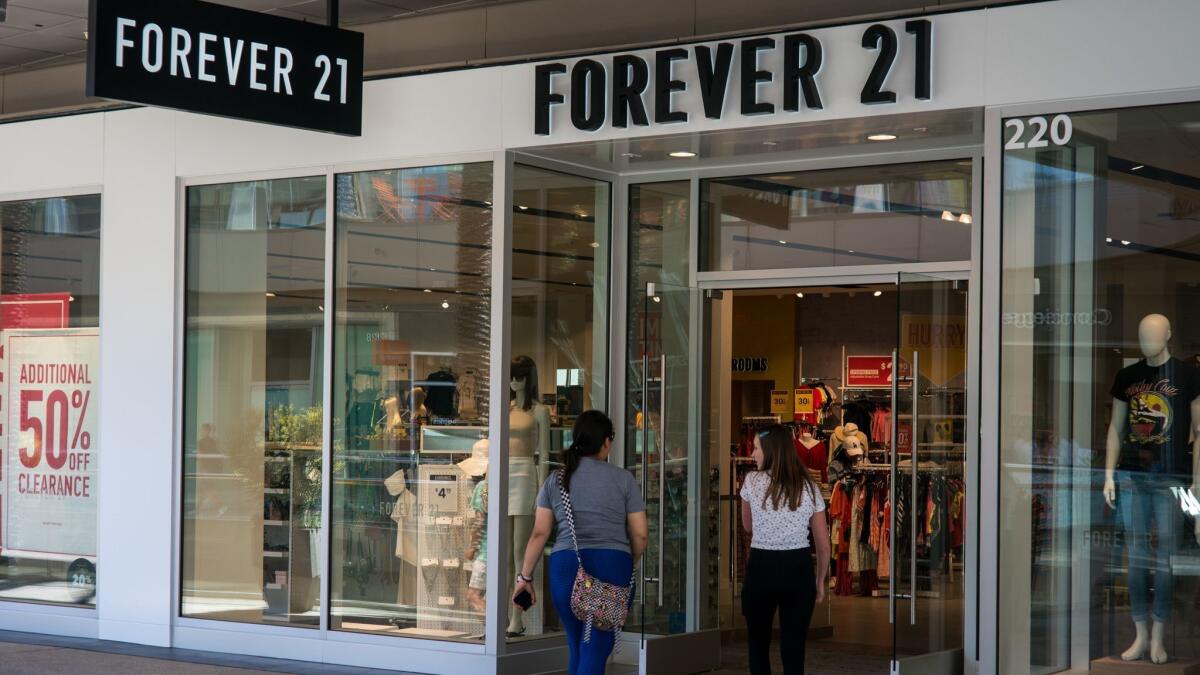Where did Forever 21 go wrong?

Nearly a decade ago, before Instagram influencers existed, Forever 21 helped teen girls dress like their favorite celebrities, for cheap.
It wasn’t a novel idea — teenage girls have always wanted to dress like their idols. The dizzying speed at which Forever 21 could make those trends available and affordable, however, was.
The company’s specialty became known as fast fashion, and the chain grew aggressively to become a staple in American shopping malls, opening hundreds of stores and redefining what it meant to be a traditional mall anchor.
But some analysts, such as Marshal Cohen of NPD Group, warned at the time that because Forever 21’s “coolness factor” might eventually fade, the company had “to be careful that they don’t get too big.”
It apparently did get too big.
Forever 21 reportedly is now in financial trouble and developing restructuring plans in hopes of avoiding a possible sale or bankruptcy. With about 800 stores worldwide and more than $3 billion in estimated annual sales, Forever 21 — a privately held family business that started with a single store in Los Angeles’ Highland Park neighborhood in 1984 — is being squeezed on multiple fronts.
The chain reportedly needs to shore up its finances just as its coolness factor is indeed ebbing and young consumers keep migrating to other retailers, especially online sellers. Forever 21’s own missteps haven’t helped, including its move to sell clothes and other merchandise for a wide variety of shoppers — a broadening of focus that diminished its reputation with young buyers, analysts said.
“They’ve lost sight of what brought them there,” said Roger Beahm, executive director of the Center for Retail Innovation at Wake Forest University. “They’ve tried to make up for it by expanding the appeal, and I think you end up diluting what you stand for.”
The resulting irony is that Forever 21, which once benefited from dying traditional retailers such as Mervyn’s and Gottschalks by taking over their shuttered stores, is now threatening to become the next major trouble spot for already ailing mall operators.
Forever 21 isn’t alone. H&M, a fast-fashion giant based in Stockholm, also is struggling. Profits at H&M have fallen, and the firm’s stock price has plunged by half in the last four years as teens and others spend more online at sites such as Fashion Nova, Asos, Missguided and Lulus, as well as e-commerce kingpin Amazon and clothing resellers such as Poshmark and Depop.
One such consumer is college student Dawn Trevino, 19, who said during a recent visit to the Third Street Promenade in Santa Monica that she now rarely shops at Forever 21 because its styles feel “cookie-cutter.”
“I want something unique, and I feel like that’s the new thing,” Trevino said.
Even the basic staples at Forever 21 let her down, she said. She’ll often find a hoodie or shirt she likes, but when flipped over they reveal phrases such as “I love tacos” or “I hate people,” and she puts them back.
Forever 21 — owned by husband-and-wife team Do Won Chang and Jin Sook Chang, who emigrated from South Korea before starting the firm — has hired restructuring advisors to explore the chain’s options, including renegotiating leases and store exits with landlords, securing a new loan or overhauling the company’s operations, Bloomberg and the Wall Street Journal reported recently.
Forever 21 declined to comment for this article, and as a private entity its financial information, including how much debt it’s carrying, is not publicly available.
The company reportedly has been downsizing some of its enormous stores, in some cases ceding parts of the outlets to other retailers. According to its website, the average Forever 21 store measures 38,000 square feet.
Its locations include a 94,000-square-foot store in San Bernardino, a 127,000-square-foot one in Las Vegas and a four-story, 90,000-square-foot emporium in New York’s Times Square.
The retailer sold its Los Angeles headquarters building for $166 million in December.
In addition, some Forever 21 officials who did not have the backing of Do Won Chang asked two of the firm’s biggest landlords, mall operators Simon Property Group Inc. and Brookfield Property Partners, about various options including a sale, Bloomberg reported. Forever 21 called that report “categorically incorrect” and said it had not had talks with landlords outside of rent negotiations.
Forever 21 is one of Simon’s and Brookfield’s largest tenants, according to those firms’ recent securities filings. And it wouldn’t be the landlords’ first time bailing out a tenant. In 2016, Simon and General Growth Properties — which has since been acquired by Brookfield — joined to buy out Aeropostale, a teen retailer that had filed for bankruptcy protection.
Forever 21 became a trailblazer in fast fashion by selling a rapidly changing assortment of young women’s dresses, tops, jeans and other apparel and accessories, typically for less than $20 apiece.
Behind a $13 shirt, a $6-an-hour worker »
Initially Fashion 21, the name was changed because “our target customers are people in their 20s,” Do Won Chang told CNN through a translator in 2012. “Old people wanted to be 21 again, and young people wanted to be 21 forever.”
Forever 21 had roughly 450 locations by 2009, and its “cheap chic” assortment was especially popular in the aftermath of the severe recession in 2008-09. Hundreds of shoppers would line up for the grand openings of its new stores.
The firm kept opening more outlets, and by 2015, the Changs had a combined net worth of $5.9 billion — but that fortune has since shrunk to $1.6 billion because of Forever 21’s problems and declining valuations among similar retailers, Forbes estimated.
As it grew, Forever 21 expanded into menswear, children’s clothing, maternity and plus-size apparel and cosmetics, among other items. But that made the chain too much like the failed, conventional department stores it replaced, said Ilse Metchek, president of the California Fashion Assn. trade group.
Metchek said teens who buy fast fashion often have a specific item or trend in mind, and when they go shopping, they “want to get in, they want to see it, they want to buy it and get the hell out of there,” she said. “They don’t want to go upstairs. It’s too much of a department store.”
As shopping shifts online, the decline in traditional mall traffic exacerbates Forever 21’s problems, said Ronald Friedman, co-head of the retail practice at Marcum, an accounting and advisory firm.
Forever 21 invested heavily in conventional malls, but “they’re just not all going to be good stores,” Friedman said. “If you have stores losing a lot of money, the good stores can’t make up for all the bad stores.”
The chain still has a vast audience; it has more than 16 million followers on Instagram. But while Forever 21 once helped set trends for millennials, many in the subsequent Generation Z population apparently are looking elsewhere for clothing inspiration, Beahm said.
“A brand popular with millennials may not be popular with Gen Z,” and it should evolve to stay ahead of the trends, Beahm said. “If you’re following and chasing them, you can find yourself in trouble.”
Metchek thinks Fashion Nova, a Los Angeles-based, online-only fast-fashion retailer known for its body-hugging silhouettes, “is the new Forever 21.”
Fashion Nova relies heavily on influencer marketing — teaming up with celebrities, bloggers and others who have large online followings and can show off the clothes, Metchek said, and it knows its shoppers: young women who want to emulate the aesthetic of the Kardashian family. Meanwhile, she said, “Forever 21 is trying to appeal to everybody.”
Forever 21 is hoping to avoid the fate of apparel retailers that have filed for bankruptcy in recent years, including not only Aeropostale but also American Apparel, Rue21, Nasty Gal, BCBG Max Azria and Wet Seal.
The landscape is rough for clothing chains. Abercrombie & Fitch plans to close 40 of its stores this year. Gap Inc. is slashing 230 of its namesake brand’s stores and splitting into two publicly held firms, spinning off its better-performing Old Navy brand.
But there is still a place for physical stores. Some shoppers like to visit malls when they want to try on clothes and make returns, or as a social activity.
As Trevino and her friend, 18-year-old Marissa Pena, walked around Third Street Promenade hunting for sales on a recent weekday, they said they browse online for clothes but can more easily figure out the right sizes in person. Photos of tall, thin models leave them unsure how the garments will look on their own 5-foot frames.
Pena showed off a pair of white sneakers she’d just bought on sale at the Steve Madden store. Her shoe size is average, and when footwear goes on sale online, her size often sells out quickly — but the right pair might be hiding in plain sight on a store shelf, she said.
The friends are still open to visiting Forever 21. That day, Pena was even wearing a pair of white sailor shorts she’d bought at one of its stores this summer when they’d proved to fit well. But before even reaching the age of 21, they feel the brand no longer offers what they’re looking for.
“It’s so hard because I like Forever 21 in some circumstances,” Pena said. “But at this age, when you’re going into internships, you need nicer clothes and ones that last, so you can’t really shop at Forever 21.”
More to Read
Inside the business of entertainment
The Wide Shot brings you news, analysis and insights on everything from streaming wars to production — and what it all means for the future.
You may occasionally receive promotional content from the Los Angeles Times.











